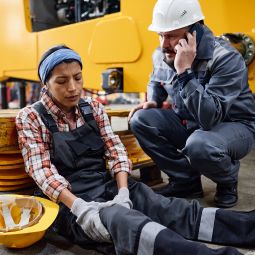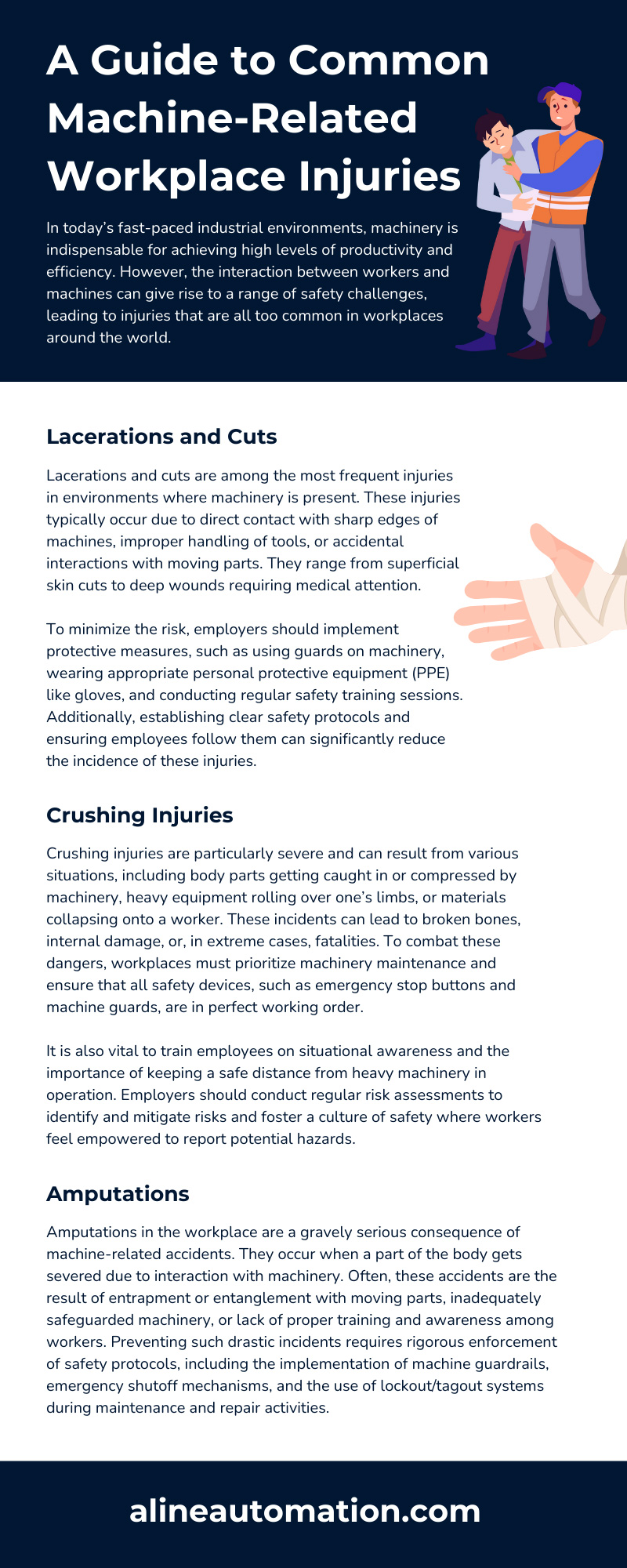
In today’s fast-paced industrial environments, machinery is indispensable for achieving high levels of productivity and efficiency. However, the interaction between workers and machines can give rise to a range of safety challenges, leading to injuries that are all too common in workplaces around the world.
Take a look at this guide to common machine-related workplace injuries to understand the most prevalent causes and gain some useful tips for preventing these issues.
Lacerations and cuts are among the most frequent injuries in environments where machinery is present. These injuries typically occur due to direct contact with sharp edges of machines, improper handling of tools, or accidental interactions with moving parts. They range from superficial skin cuts to deep wounds requiring medical attention.
To minimize the risk, employers should implement protective measures, such as using guards on machinery, wearing appropriate personal protective equipment (PPE) like gloves, and conducting regular safety training sessions. Additionally, establishing clear safety protocols and ensuring employees follow them can significantly reduce the incidence of these injuries. Workers must be made aware of the potential hazards and trained in the proper operation and maintenance of machinery to create a safer working environment.
Crushing injuries are particularly severe and can result from various situations, including body parts getting caught in or compressed by machinery, heavy equipment rolling over one’s limbs, or materials collapsing onto a worker. These incidents can lead to broken bones, internal damage, or, in extreme cases, fatalities. To combat these dangers, workplaces must prioritize machinery maintenance and ensure that all safety devices, such as emergency stop buttons and machine guards, are in perfect working order.
It is also vital to train employees on situational awareness and the importance of keeping a safe distance from heavy machinery in operation. Employers should conduct regular risk assessments to identify and mitigate risks and foster a culture of safety where workers feel empowered to report potential hazards.
Amputations in the workplace are a gravely serious consequence of machine-related accidents. They occur when a part of the body gets severed due to interaction with machinery. Often, these accidents are the result of entrapment or entanglement with moving parts, inadequately safeguarded machinery, or lack of proper training and awareness among workers. Preventing such drastic incidents requires rigorous enforcement of safety protocols, including the implementation of machine guardrails, emergency shutoff mechanisms, and the use of lockout/tagout systems during maintenance and repair activities.
Regular comprehensive training programs that emphasize the importance of safety practices and equipment handling procedures are essential. Creating an environment where employees are encouraged to communicate openly about potential risks and safety concerns can significantly contribute to reducing the likelihood of amputations.
Burns in the workplace, particularly in settings involving machinery, can arise from several sources, including chemical exposures, electrical accidents, or coming into contact with hot surfaces or flames. These injuries can range from minor surface burns to severe injuries requiring extensive medical treatment. To prevent such incidents, companies must ensure that employees receive training on the risks associated with handling hazardous materials, operating heat-generating equipment, and working near electrical components.
The use of PPE tailored to the specific hazards of the environment, such as gloves, aprons, and face shields, plays a crucial role in safeguarding workers. Additionally, emergency response plans and first-aid training are essential components of a comprehensive strategy to manage and mitigate the effects of burn injuries in the workplace.
Electrical shocks in the workplace present a significant risk, particularly in areas where employees frequently use machinery and electrical equipment. These incidents can occur due to direct contact with live parts, faulty equipment, or improper use of electrical devices. The severity of electrical shocks can range from minor discomfort to life-threatening injuries, including cardiac arrest. To mitigate these risks, employers must enforce strict electrical safety protocols, including regular inspections of electrical equipment, proper grounding of electrical devices, and the use of circuit breakers.
It is essential to train employees on the safe handling of electrical tools and equipment and the proper response to electrical emergencies. Additionally, employing lockout/tagout procedures to ensure machinery is safely de-energized before maintenance can prevent accidental electrocution.
Repetitive strain injuries (RSIs) are prevalent in workplaces where tasks are monotonous and require continuous movement repetition. These injuries develop over time due to the overuse of particular muscle groups, leading to conditions such as tendonitis and carpal tunnel syndrome. Common symptoms include pain, aching, or numbness, which can severely impact an employee’s ability to perform work-related tasks.
To prevent RSIs, employers should encourage regular breaks, provide ergonomic equipment that supports proper posture, and design workstations that allow for variations in body movement. Additionally, promoting a workplace culture that values health and safety through regular training on ergonomic practices can greatly reduce the risk of these injuries. Ensuring that employees are aware of the signs of RSIs and providing early intervention strategies are key components of effective injury prevention.
Falls and slips near machinery represent a significant hazard, leading to injuries that range from minor bruises to serious fractures or even concussions. These accidents typically occur due to slippery surfaces, cluttered work areas, or inadequate lighting around the machinery. To minimize these risks, workplaces must prioritize cleanliness and organization, ensuring that employees promptly clean spills and keep walkways near machinery clear of debris. Proper lighting is essential to help workers navigate safely around equipment.
Installing anti-slip flooring and handrails can substantially reduce the risk of falls. Equally important is the provision of proper footwear designed to offer traction and support in environments where machinery is common. Regular safety drills and training sessions can further enhance awareness and preparedness among workers, significantly decreasing the occurrence of falls and slips in industrial settings.
The industrial workplace, with its reliance on complex machinery and processes, inherently carries the risk of common machine-related injuries. From lacerations and crush injuries to electrical shocks and falls, the potential for harm is diverse. However, by implementing comprehensive safety protocols, regular maintenance, and thorough training, employers can significantly reduce these risks. They must also foster a culture of safety that prioritizes the well-being of their employees above all else. Employing protective measures, such as personal protective equipment and ergonomic practices, alongside creating an open environment for reporting hazards, can lead to a safer, more productive workplace.
If you need industrial safety fencing to protect your workers from machinery hazards, A-Line Automation can help. With over 25 years of experience in the industry, we offer a wide range of safety solutions to keep your workplace secure. Contact us today for more information about our products and services.
